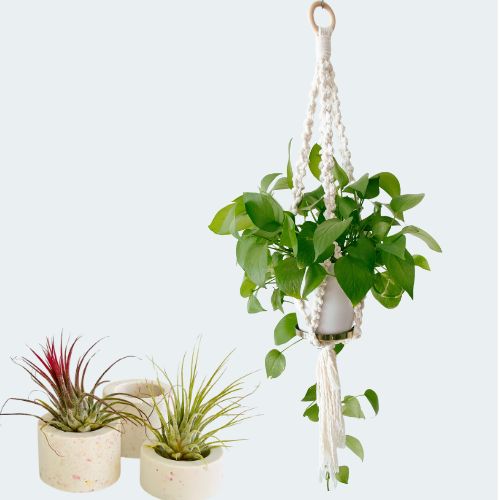
How to Make Your Own DIY Plant Holders and Hanging Planters: A Step-by-Step Guide
Adding greenery to your home is a great way to freshen up your space, improve air quality, and create a calming atmosphere. Plant holders and hanging planters are excellent ways to display your plants, and making them yourself adds a personal touch to your home décor. This step-by-step guide will walk you through how to create stylish, functional DIY plant holders and hanging planters using simple materials. These projects are budget-friendly and suitable for all skill levels, providing a creative way to elevate your indoor and outdoor garden displays.
Why Make Your Own DIY Plant Holders and Hanging Planters?
Making your own plant holders and hanging planters offers several advantages:
- Customization: Tailor your plant holders to fit your space and aesthetic preferences, from minimalist designs to bold, colorful creations.
- Cost-Effective: DIY projects can save you money compared to purchasing store-bought holders, and they allow you to repurpose materials you might already have at home.
- Sustainability: Repurposing items like old containers or scrap wood helps reduce waste and promotes eco-friendly practices.
- Creative Expression: DIY plant holders give you the freedom to experiment with different materials, styles, and designs, making your plant display unique.
Step 1: Gather Your Materials
Before starting your DIY plant holder or hanging planter, gather the necessary materials based on the type of holder you want to create. Here are some common materials used in these projects:
- Pots and Containers: Terracotta pots, mason jars, ceramic bowls, wooden boxes, or even tin cans can serve as the base for your plant holder.
- String or Rope: For hanging planters, you’ll need sturdy string, macramé cord, or jute rope to suspend your plant holder.
- Hooks and Fasteners: Use ceiling hooks or wall brackets to hang your planters securely.
- Paint and Brushes: Acrylic paint, spray paint, or chalk paint for adding color and design to your plant holders.
- Drill: If you need to add drainage holes to your container or attach hooks for hanging.
- Soil and Plants: Choose plants that fit the size of your holder, such as succulents, small ferns, or trailing vines.
Step 2: DIY Plant Holder Ideas
Here are a few creative and functional DIY plant holder ideas to get you started. Each project offers a unique way to display your plants while adding a decorative touch to your space.
1. Repurposed Tin Can Planters
Repurposing tin cans is an affordable and eco-friendly way to make plant holders. You can customize them with paint, stencils, or wrapping them in fabric for a chic, upcycled look.
Instructions:
- Thoroughly clean and dry your tin cans.
- Paint the cans in your desired colors, or leave them natural for a rustic look.
- Use a nail and hammer to create drainage holes at the bottom of each can.
- Fill the can with soil and your chosen plant, such as herbs, succulents, or small flowers.
- Optionally, attach hooks or mount the cans to a wooden plank for a vertical garden display.
Tip: Group several painted tin cans together for a coordinated and stylish plant display on a windowsill or outdoor patio.
2. Macramé Hanging Planter
Macramé hanging planters are a trendy way to display plants in a suspended format. The woven cords add a boho-chic style to your home, and they’re easier to make than you might think.
Instructions:
- Cut four equal lengths of macramé cord, about 3–4 feet each, depending on how low you want the planter to hang.
- Tie all four cords together at the top with a knot, leaving a loop for hanging.
- Separate the cords into pairs and tie knots in each pair about 6 inches down from the top knot.
- Repeat the process, alternating the cords and tying knots about 2–3 inches below the previous knots.
- Place your plant pot in the center of the cords and adjust the knots as needed to fit securely around the pot.
- Hang the macramé planter from a ceiling hook or bracket.
Tip: Use different colored cords or beads to personalize your macramé planter and match your home décor.
3. Wooden Plant Stand
For a more structured plant holder, a wooden plant stand is both stylish and functional. You can build a simple stand using basic woodworking tools or repurpose scrap wood.
Instructions:
- Cut four equal pieces of wood for the legs and two shorter pieces for the top frame.
- Assemble the frame by attaching the shorter wood pieces to the tops of two legs on either side, creating a square or rectangular base.
- Secure the legs to the frame with screws or wood glue.
- Sand and paint or stain the stand to match your décor.
- Place your plant pot on top of the stand for an elevated, modern look.
Tip: For a more creative twist, use reclaimed wood or paint the legs in contrasting colors for a two-tone effect.
4. Hanging Mason Jar Planters
Mason jars make great hanging planters for small plants like succulents or herbs. They’re perfect for indoor gardens or for adding greenery to small spaces like balconies.
Instructions:
- Fill each mason jar with small pebbles for drainage, followed by potting soil.
- Plant your chosen herbs or succulents inside the jars.
- Wrap wire or jute rope tightly around the neck of each jar to create a secure handle.
- Attach the jars to hooks on a wooden plank or hang them individually from ceiling hooks.
Tip: Hang several mason jar planters at different heights for a dynamic, layered look.
5. Clay Pot Planter with Wooden Frame
A simple clay pot can be transformed into an elegant hanging planter when paired with a minimalist wooden frame.
Instructions:
- Use a wooden hoop or create a square frame with thin wooden slats.
- Place the clay pot inside the frame, resting the rim on the edges of the wood.
- Attach a hanging cord or chain to the top of the frame.
- Hang the planter from a ceiling hook or wall bracket.
Tip: Paint the wooden frame or clay pot in coordinating colors for a cohesive design.
Step 3: Customize Your Plant Holders
One of the best parts of DIY projects is the ability to customize your plant holders to match your style and needs. Here are some ideas to personalize your plant holders:
- Paint Techniques: Try stenciling patterns, ombré effects, or geometric designs on your plant holders for a pop of color.
- Distressing: For a rustic or vintage look, use sandpaper to lightly distress the edges of painted holders.
- Decorative Additions: Wrap holders with twine, lace, or ribbon for added texture and charm.
Step 4: Incorporating Your DIY Plant Holders Into Your Home
Once your plant holders and hanging planters are complete, it’s time to find the perfect spots to display them. Here are a few ways to incorporate them into your home décor:
- Living Room: Display large plant holders in corners or near windows to add life and greenery to your living space.
- Kitchen: Hang herb planters near your kitchen window for easy access to fresh herbs while cooking.
- Patio or Balcony: Use hanging planters to maximize space in small outdoor areas and create a vertical garden.
Step 5: Plant Care Tips
After completing your DIY plant holders and hanging planters, make sure to give your plants the proper care:
- Lighting: Place your plants in areas where they will receive the appropriate amount of light based on their needs.
- Watering: Ensure your containers have drainage holes to prevent root rot, and water plants based on their specific requirements.
- Pruning: Regularly prune and trim your plants to keep them healthy and encourage growth.






